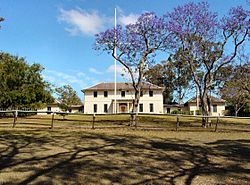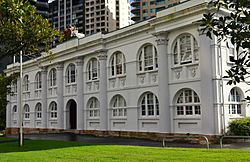John Watts (military architect) facts for kids
John Cliffe Watts (born May 7, 1786 – died March 28, 1873) was an Irish soldier and architect. He designed some of the first important public buildings in the new British colony of New South Wales in Australia. Later, he became the head of the postal service in South Australia. People often called him "Captain Watts."
Contents
Early Life and Army Start
John Watts was born in Sallins, a village in County Kildare, Ireland. His parents were Charles and Margaret Watts. He had seven brothers, and all of them, including John, became army officers. Five of them, including John, became a Captain.
John finished his schooling by 1802. After that, he worked briefly at a bank in Dublin. Then, he spent about 18 months working for a company of architects.
Joining the Army
On July 24, 1804, John Watts joined the army as an ensign (a junior officer). He was part of the 64th Regiment of Foot, which was stationed in the West Indies at the time. In 1805, he was promoted to lieutenant and moved to the 46th Regiment.
In early 1810, he helped capture the island of Guadeloupe from the French. He returned to England with his regiment in 1811. They were stationed on Jersey and later on the Isle of Wight.
Life in New South Wales
Working for the Governor
In August 1813, John Watts's regiment, the 46th, was sent to the colony of New South Wales. They were there to replace another regiment. Watts sailed on a ship called Windham and arrived in Sydney on February 11, 1814.
On June 3, 1814, he became an aide-de-camp (a personal assistant) to the Governor of New South Wales, Lachlan Macquarie. Watts became a close friend to Governor Macquarie and his wife, Elizabeth.
Governor Macquarie wanted to help former convicts (called emancipists) become part of free society. Many free settlers and soldiers disagreed with this. But Watts supported the Governor. Governor Macquarie even wrote to important people in England, praising Watts for his loyalty. Watts lived with the Macquaries for five years and was treated like family.
Designing Buildings

Governor Macquarie was always building new things in the colony. Since there weren't many architects, he soon used Watts's skills. Watts designed a new military hospital on what is now called Observatory Hill in Sydney. This building later became Fort Street High School and is now the headquarters for the National Trust of Australia. The original part of Watts's design is still inside.
Because his first project was successful, Watts got more jobs. Many of these were in the new inland settlement of Parramatta.
- In 1815-16, he worked on improving Government House in Parramatta.
- He designed a hospital in Parramatta (1817–18).
- He designed military barracks (1818-20).
- He added two steeples to St John's Church in Parramatta (1818–19).
- He helped repair roads and bridges between Sydney and Parramatta.
- He built a dam across the Parramatta River in 1818.
Mrs. Macquarie thought the dam was Watts's best work. It greatly improved the water supply for Parramatta, which often had water shortages in summer. Watts also went on tours with the Macquaries to places like Bathurst and the Cowpastures area (near modern Camden).
Leaving New South Wales
In 1818, Watts decided to leave his position as aide-de-camp. He wanted to go to England to seek a promotion in the army. Governor Macquarie gave him two years' leave from his regiment.
The Governor publicly thanked Watts in the Sydney Gazette newspaper on January 2, 1819. He praised Watts for his "architectural services and Taste." After finishing some urgent work on the military barracks in Parramatta, Watts sailed for England on April 1, 1819. He carried official messages and gifts for the Royal Family and the Secretary of State.
Life in Britain and South Australia
After arriving in Britain, Watts was promoted to the rank of Captain on February 24, 1820. In 1822, he visited the Macquaries in Glasgow, Scotland. There, he met and fell in love with Elizabeth Macquarie's niece, Jane Campbell. They married on January 16, 1823.
Watts left the army in 1824. He and Jane settled in Campbeltown, Scotland, where they raised seven children. In 1837, he moved his family to Dublin, Ireland.
Moving to South Australia
In 1840, Watts decided to move to the colony of South Australia. His brother Henry was already the Postmaster there. John Watts and his family left Scotland on September 17, 1840, and arrived in Port Adelaide, South Australia, on March 8, 1841.
On April 1, 1841, he became the Postmaster General for South Australia, taking over from his brother. He held this important job for 20 years. He was also one of the first trustees of the Savings Bank of South Australia.
John Watts retired on June 29, 1861. He was an active member of the Aborigines' Friends' Association, which worked to support Aboriginal people.
Captain Watts passed away in North Adelaide in 1873, at nearly 87 years old.
Images for kids






